Propane is an essential resource when it comes to RVing, and running out may not only be inconvenient but can be dangerous as well.
It powers the furnace and water heater to give us warmth, as well as most stovetops, ovens, and refrigerators.
Propane tanks come in a wide variety of sizes and shapes and sizes, and choosing the right size propane tank can help to know how long your RV’s propane supply will last.
But how are you supposed to really know which tank is right for your RV?
While larger motorhomes usually have larger built-in tanks, towable campers tend to have one or more removable cylinders.
Although larger tanks can hold more propane, a series of smaller cylinders may result in a greater overall supply.
How long the supply will last also depends on how you travel and how much you use your appliances.
In this ultimate RV propane tank guide, can help you determine the right size propane tank for your motorhome or travel trailer.
We’ll compare the different sizes and types of propane tanks found in RVs, as well as the best way to calculate how long your RV’s propane supply will last.
RV Propane Tank Sizes
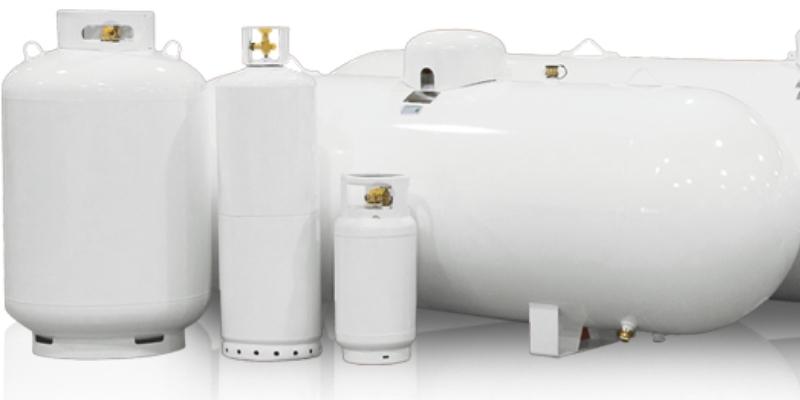
RV propane tank sizes can vary based on your RV type and the types of tanks that it carries.
While motorhomes come with permanently installed ASME tanks, towable campers tend to have smaller DOT cylinders that can be alternated between or switched out.
Propane tanks are measured in pounds, with the smallest tanks starting at 7 lbs. and large industrial tanks ranging to 1000 lbs.
The most common propane tank sizes found in RVs are 20lb., 30lb., and 40lb. tanks. However, while some small campers may only be equipped with a single 20 lb. tank, larger RVs may have multiple 30 or 40 lb. tanks.
The chart below shows common RV propane tank sizes and their maximum capacities.
| Propane Tank Size | Gallons of Propane |
|---|---|
| 7 lb. tank | 1.6 gallons |
| 11 lb. tank | 2.5 gallons |
| 20 lb. tank | 4.7 gallons |
| 30 lb. tank | 7 gallons |
| 40 lb. tank | 9.4 gallons |
| 100 lb. tank | 25 gallons |
Types of RV Propane Tanks
There are two types of RV propane tanks – those that are permanently installed to the RV and those that can be removed.
ASME Propane Tanks
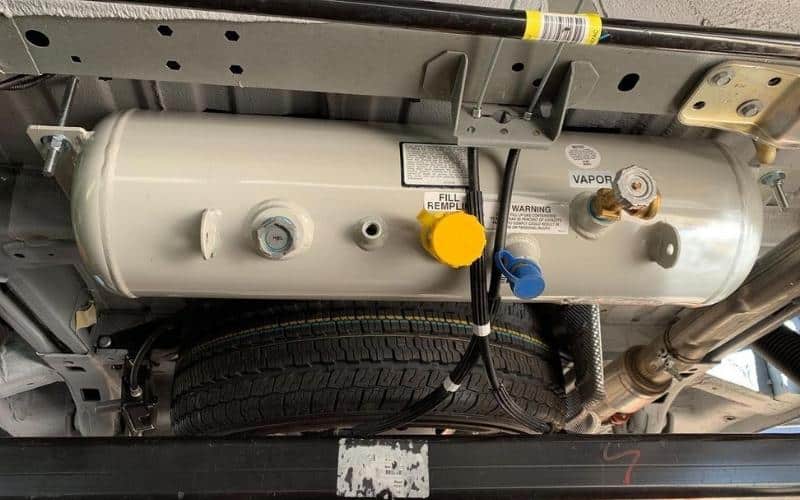
ASME tanks are approved by the American Society of Mechanical Engineers.
They are bolted to the frame of the RV and are not removable. They can be found in large Class C and Class A motorhomes.
DOT Cylinders
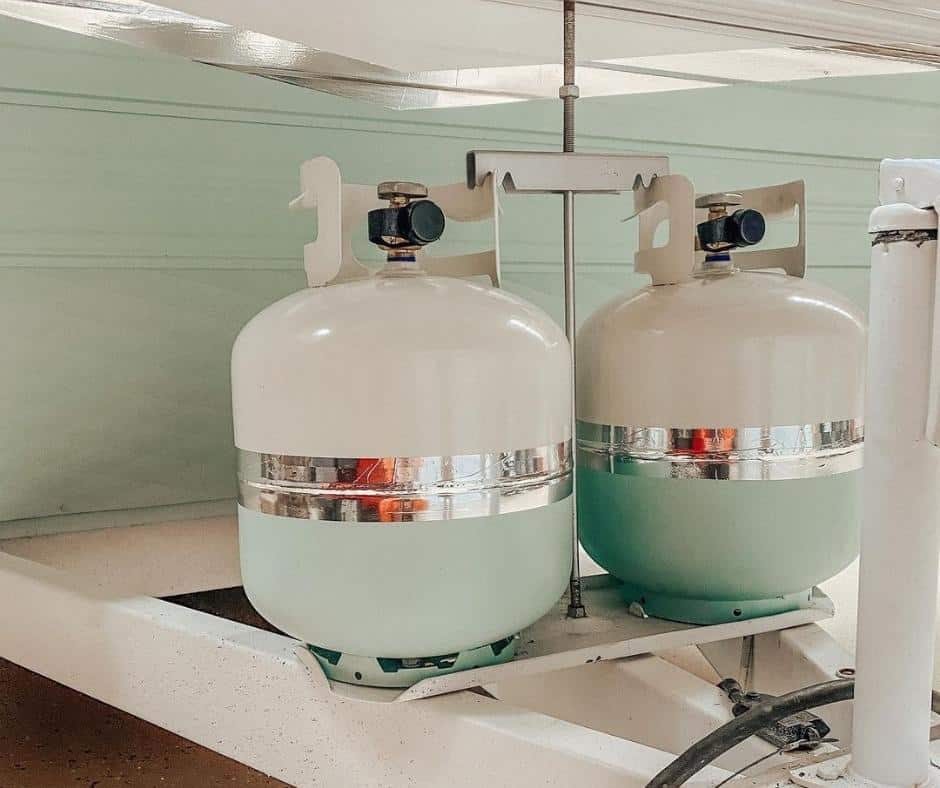
DOT cylinders are removable tanks that sit on the exterior of your RV. They are approved by the Department of Transportation and can be found on the following types of RVs:
Depending on the type of RV, DOT cylinders can either be found in exterior compartments or on holders located on either the tongue or bumper of the RV.
Should You Install an ASME or DOT Propane Tank In Your RV?
When choosing an RV, it is important to consider how you plan to travel in it, and part of this consideration should be the propane supply.
Although both types of propane tanks serve the same basic functions, there are some notable differences in how they are made, used, and cared for.
Let’s take a side-by-side look at what you can expect with each type of tank.
Mobility
ASME propane tanks are permanently installed to your RV. This means that whenever they need to be filled or need any sort of maintenance, the entire vehicle must go.
These are usually found in motorized RVs that are often also the primary mode of transportation during travel.
However, ASME tanks may become a hassle if you plan to primarily keep your RV stationary.
DOT cylinders can be removed from the RV and transported separately. They are found on RVs that require a separate vehicle and on some small, motorized RVs.
DOT cylinders allow you to leave your camper at a chosen location when you need to fill up on propane.
They also allow the option of exchanging an empty tank for a spare to extend your overall supply.
Weight
ASME propane tanks are heavier than DOT cylinders of a comparable size because they are made of thicker steel.
Thicker steel protects against damage, and they can be heavier because they don’t require any physical lifting.
DOT cylinders are made to be lifted and transported, so they are made to be the lighter propane tank option.
They are made of thinner steel than ASME tanks, and those found on RVs are usually not larger than 40 pounds.
The weight of your tank or cylinder when empty can be found stamped onto the vessel itself.
You will find an expiration date alongside two letter and two numbers. For example, TW40 means that your tank weight is 40 pounds.
Knowing the weight of your propane supply will not only ensure that you can physically transport DOT cylinders, but it will also help you determine your RV’s gross vehicle weight (GVW) as well as proper weight distribution.
Calculating the Weight of a Full Propane Tank
To calculate the weight of a propane tank when filled, you’ll need the following information:
- Begin with the dry weight of your tank. A 30 lb. DOT cylinder may have TW24.2 stamped on it, indicating the empty tank weighs 24.2 lbs.
A 30 lb. tank can hold approximately 7 gallons of propane. Multiply the gallons by 0.8 to find how many gallons it will normally hold when filled.
7 lbs. x0.8 = 5.6 gallons
- Multiply the number of gallons that your tank will hold when filled to 80% capacity by the weight of each gallon.
5.6 gallons x 4.24 pounds = 23.74
- Add the weight of the dry tank with the weigh of the propane to find the maximum total weight of your tank.
24.2 + 23.74 = 47.94 lbs.
Answer: A 30 lb. DOT cylinder will weigh approximately 48 pounds when filled to a safe capacity.
Maintenance
As with most of the equipment found in your RV, both ASME propane tanks and DOT cylinders require regular maintenance to keep them in their best shape. Basic maintenance steps include:
In addition to regular maintenance, DOT cylinders need to be recertified 12 years after their manufacture date.
This can be done at most locations that sell propane, and the type of test performed will determine the length of time until the next recertification.
Small cylinders up to 20 lbs. can easily be exchanged anywhere that sells propane, though it’s generally cheaper to just refill your tank.
As long as they are in good shape, neither ASME tanks nor DOT cylinders ever need to be replaced.
However, use caution and have you tanks checked by a professional if you ever notice rust, cracks, or bulging on the tank.
How Long Will Your RV’s Propane Supply Last You?
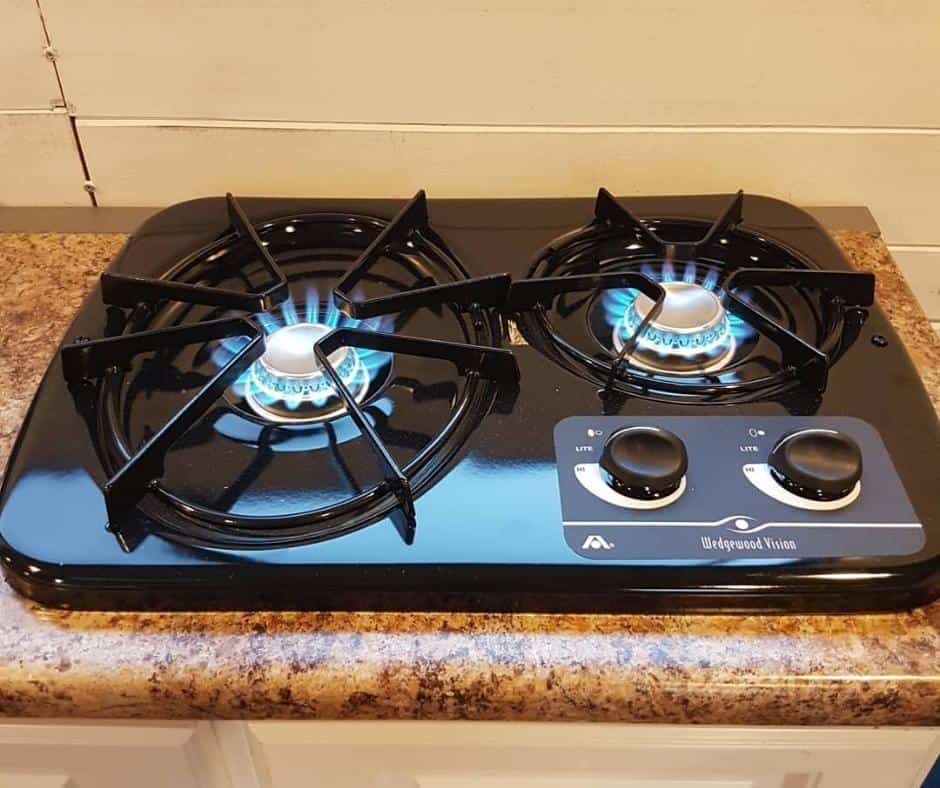
One of the most important things to know about your propane supply is how long it will last you.
It’s not fun to run out of propane while cooking, and it can even be dangerous to run out of propane in cold winter months.
The best way to get the most accurate idea of how long your supply will last is by testing it out first-hand.
If possible, keep your first few camping trips with a new RV somewhere near civilization for the option to quickly refill your propane in case you accidentally run out.
Even if you don’t go through a full tank, you can use a gauge to get an idea of how much of your supply you use on a regular basis.
What Size RV Propane Tank Do You Actually Need?
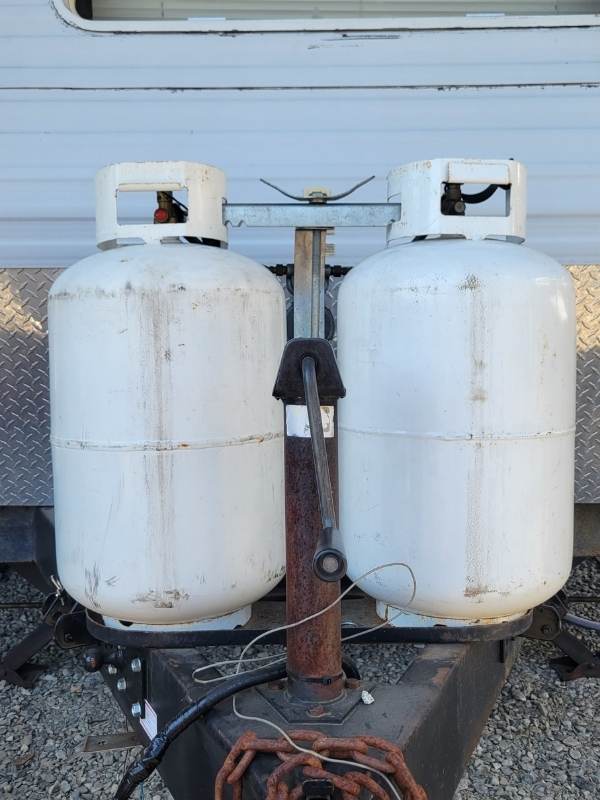
There are many factors that can affect how much propane you may go through, and these need to be taken into consideration when performing the calculations.
For example, traveling in cold weather will bring you to using the furnace much more than traveling in warm weather.
Boondocking or otherwise camping without hookups will also make you more heavily reliant on propane.
With full hookups, many fridges are able to run on electricity instead, while campsite resources such as bathrooms and grills may also help you save on propane when showering and cooking.
To calculate approximately how long your propane supply will last, you’ll need a few pieces of information, including:
Let’s walk through the series of calculations necessary to calculate how long your RV propane supply will last, using a travel trailer with two 30 lbs. DOT cylinders as an example.
1. Calculate your propane tank capacity.
Use the pound to gallon calculations explained above to determine your total supply.
Remember that 1 gallon of propane = 4.24 pounds, and that propane tanks should only be filled to 80% capacity.
We can use the chart to determine that one 30 lb. cylinder can hold 7 gallons of propane, and two 30 lb. propane tanks means 14 gallons total.
At 80% capacity, this comes to 11.2 gallons of propane.
14 x 0.8 = 11.2
2. Calculate the total BTUs that a full propane supply will provide.
1 gallon of propane contains 91,452 BTU. Multiply the total gallons of propane found in the previous calculation by 91,452 to determine the total BTUs of your supply.
11.2 gallons of propane x 91,452 BTU per gallon = 1,024,262.4 BTU
3. Calculate the daily consumption rate of your appliances
This step is not difficult, though it may require finding the owner’s manual.
All appliances have a BTU rating that gives its propane consumption per hour when running at full capacity.
Find these numbers for each RV appliance that uses propane. These commonly include:
-
Furnaces (~20,000 – 40,000 BTU/hr.)
-
Refrigerators (~1,500 BTU/hr.}
-
Water Heaters (~30,000 – 50,000)
-
Ranges and Ovens (~10,000 BTU/hr.)
Once you find the BTU rating, multiply that by approximately how many hours a day that appliance will be in use.
Add the daily BTU usage rates of all appliances together to calculate how many BTUs you’ll burn per day.
Let’s say the travel trailer is being used by two people who are traveling in the fall. The days are comfortable, but the evenings tend to cool down.
They generally use the stove for about 15 minutes to boil water or cook in the morning, and for about 45 minutes to make dinner in the evenings, coming to about 1 hour of use per day.
1 hour = 10,000
They also run the furnace most evenings. It runs for fifteen minutes every half hour for four hours until they go to bed. Bringing it to 2 hours per day.
2 hours = 20,000
They take a shower once a day, which turns the water heater on for about half an hour each day.
0.5 = 15,000
They also prefer to boondock, meaning their refrigerator is running off propane 24 hours a day.
24 hours = 36,000
Now, let’s add these together to find the daily BTU rate.
10,000 + 20,000 + 15,000 + 36,000 = 81,000 BTU per day
4. Calculate How Long Does an RV Propane Tank Last.
Do so by dividing the total BTUs of your RV propane supply by the daily consumption rate of your appliances.
This will give you an approximate idea of how many days your propane supply will last in a travel trailer.
Total BTUs = 1,024,262.4
Daily consumption rate = 81,000
1,024,262.4 / 81,000 = 12.65 days
Pretty straight forward, right? With the above calculations, two people can comfortably travel for over 12 days before having to refill on propane.
**Pro Tip: If you have multiple DOT cylinders, it is best to use one tank at a time. This way, you will always have another full tank available once the first runs out.
How to Monitor Propane Tank Levels
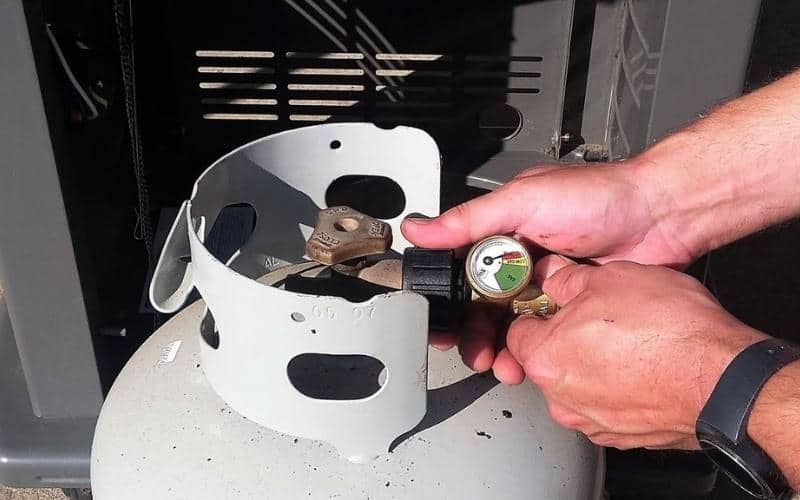
A few cold nights in which you run the furnace or baking a cake for a special occasion can burn propane that we would not otherwise use.
Do this enough times and you may run out of propane sooner than expected.
Propane tank gauges are a great way to monitor your propane tank levels. They do so by measuring the pressure within the tank.
Keep in mind that propane tank pressure can fluctuate up to 10% with changes in temperature and elevation.
While ASME tanks generally come with a built-in propane gauge, DOT cylinders will require a separate gauge attachment.
Tips For Making Your Propane Supply Last Longer
Simple habit changes to conserve your propane supply can save you on money and on trips to refill.
They can also be especially useful in colder months and when camping without hookups.
Below are a few simple ways to make your propane supply last longer:
RV Propane Safety Tips
Propane tanks are generally low maintenance and an easy and efficient way to power the necessary appliances in your RV.
However, there are a few safety tips that every RVer should follow to avoid potentially dangerous situations.
Propane tank covers are a great way to help protect exterior DOT cylinders from the elements, from unwanted critters, and during travel.

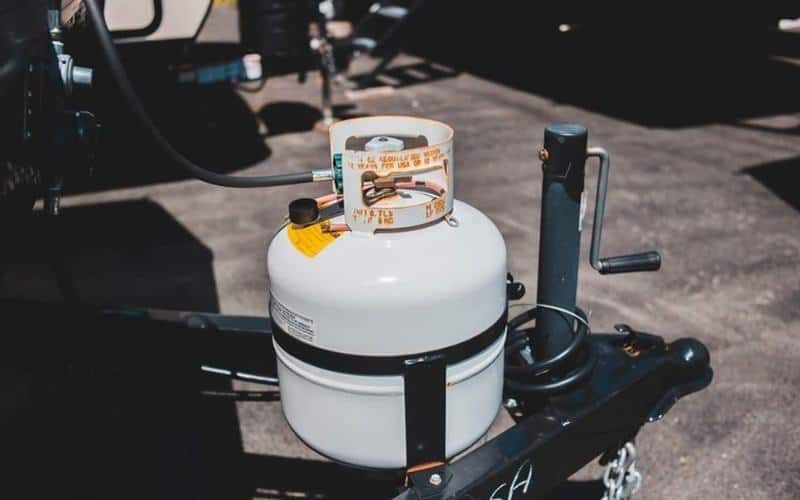


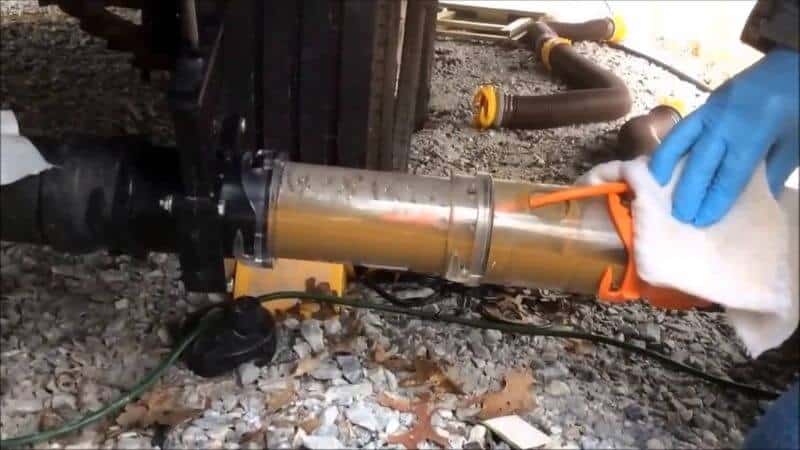
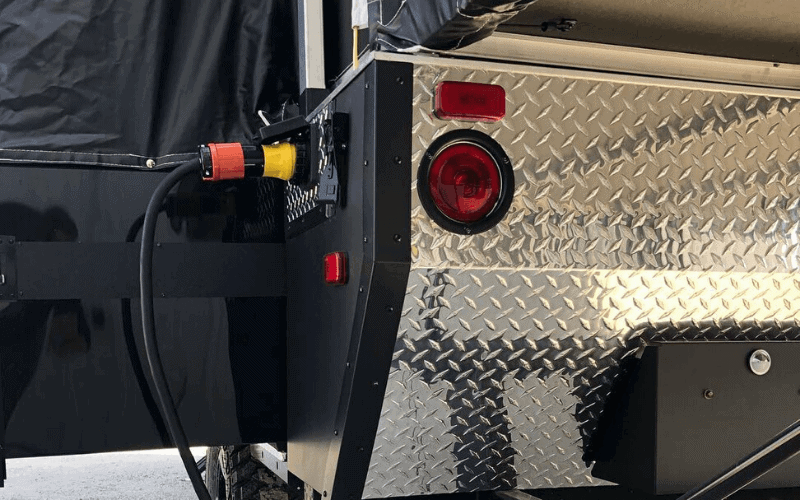
![9 Best Fuel-Efficient RVs for Maximum Gas Mileage in [currentyear] (Class A to Class C RVs) 12 9 Most Fuel Efficient RVs That Offer You The Best Gas Mileage](https://www.rvingknowhow.com/wp-content/uploads/2022/03/9-Most-Fuel-Efficient-RVs-That-Offer-You-The-Best-Gas-Mileage.jpg)